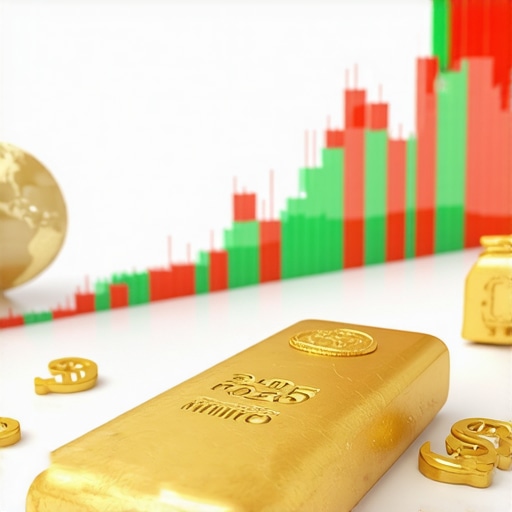Understanding the gold demand trends is crucial for investors looking to navigate the complexities of the gold market. As the global economy experiences fluctuations, gold often emerges as a safe haven asset. This article explores the key trends in gold demand and their implications for investors.
Current Trends in Gold Demand: What Investors Need to Know
Gold demand has been on a rollercoaster ride in recent years. Factors like inflation, geopolitical tensions, and changes in consumer behavior significantly impact the market. Investors should be aware of how these trends shape the demand for gold and, consequently, its price.
In 2023, we observed an uptick in demand driven by economic uncertainty. Central banks around the world have been accumulating gold as a hedge against inflation and currency devaluation. This trend is particularly prominent in emerging markets where economic instability is more pronounced. For instance, countries like India and China continue to showcase robust demand for gold jewelry, which remains a cultural staple.
The Role of Central Banks in Gold Demand
Central banks play a pivotal role in shaping the gold investment landscape. Their purchases can signal confidence in gold as a long-term investment strategy. The recent trend of central bank purchases reflects a strategic move toward diversification and risk management. As they accumulate gold reserves, it can lead to increased prices, making it an attractive option for retail investors as well.
Moreover, the resurgence of gold-backed financial products, such as gold ETFs, has made investing in gold more accessible. These products allow investors to gain exposure to gold prices without the challenges of physical ownership, thus broadening the market.
Factors Influencing Gold Demand
Several key factors influence gold demand, including:
- Economic Indicators: Inflation rates, interest rates, and currency stability can cause fluctuations in gold demand. High inflation typically increases gold’s appeal as a hedge.
- Geopolitical Tensions: Conflicts and uncertainties can drive investors toward gold as a safe haven, boosting demand.
- Cultural Factors: In many cultures, gold is a symbol of wealth and is often purchased for weddings and festivals, sustaining a steady demand.
For investors, understanding these factors is essential for making informed decisions. By keeping abreast of market conditions and trends, you can position yourself to take advantage of shifts in gold prices.
In conclusion, the evolving gold demand trends present both challenges and opportunities for investors. By staying informed about market dynamics and the factors driving demand, you can navigate the gold market more effectively and make sound investment choices. For more detailed insights, consider exploring our page on analyzing market trends.
Understanding Gold Prices: Key Influencers and Trends
The dynamics of gold demand are closely tied to the fluctuations in gold prices. Investors should recognize that various external factors, including economic indicators and market sentiment, can significantly impact gold prices. The interplay between supply and demand, as well as investor behavior, creates a complex environment for those looking to invest in gold.
The Impact of Inflation on Gold Demand
Inflation often drives gold demand as it erodes purchasing power. When inflation rates rise, investors typically flock to gold as a hedge, which can lead to increased prices. Understanding this relationship is crucial for those looking to navigate the market effectively. In times of high inflation, the allure of gold as a safe asset intensifies, prompting both retail and institutional investors to increase their holdings.
Geopolitical Events and Their Influence
Geopolitical tensions, including conflicts and trade disputes, can heighten uncertainty in financial markets. During such times, gold is often viewed as a reliable store of value. For example, the ongoing tensions between major economies can lead to spikes in gold prices, making it essential for investors to stay informed about global events. Being aware of these geopolitical factors can help investors make proactive decisions regarding their gold investments.
Long-Term Benefits of Holding Gold in Your Portfolio
Incorporating gold into your investment portfolio can offer several long-term benefits. Gold acts as a diversification tool, helping to mitigate risks associated with stock market volatility. By balancing your portfolio with gold, you can enhance its resilience during economic downturns. Moreover, investors often view gold as a hedge against currency fluctuations, particularly in times of economic uncertainty.
Gold as a Hedge Against Currency Devaluation
As central banks implement monetary policies that can lead to currency devaluation, gold’s role as a hedge becomes increasingly important. For instance, during periods of low-interest rates, holding gold can be more attractive than holding cash or bonds. This shift in strategy encourages investors to seek out gold as a means of preserving wealth, especially in a volatile economic landscape. To learn more about why gold is essential as a hedge in 2025 markets, check out our insightful article on the case for gold as a reliable investment hedge.
Best Gold Investments for Beginners: Tips and Strategies
For those new to gold investing, understanding the best investment strategies is crucial. Beginners should consider starting with gold ETFs or mutual funds, as they offer exposure to gold without the complexities of physical ownership. These investment vehicles allow beginners to easily tap into the gold market and benefit from its potential growth.
Exploring Gold IRA Options for Retirement Planning
Another option for long-term investors is exploring gold IRA options. Investing in a gold IRA is a strategic way to incorporate gold into your retirement portfolio while enjoying tax advantages. This method not only diversifies your investments but also ensures that you are prepared for future financial needs. Understanding how to set up a gold IRA can be a valuable asset for investors planning for retirement.
As the landscape of gold demand trends continues to evolve, staying informed about the factors influencing these trends is vital. By understanding market dynamics, geopolitical influences, and investment strategies, you can navigate the gold market more successfully and make informed decisions that align with your financial goals. For more insights into current trends in the gold market, visit our comprehensive analysis page.
Effective Strategies for Safe Gold Trading Investments
Investing in gold requires a strategic approach, especially when navigating the complexities of gold trading. To maximize your returns, it’s essential to develop a comprehensive understanding of market trends and trading techniques. One proven strategy is to establish a clear investment goal. Whether you’re looking for short-term gains or long-term stability, defining your objectives can guide your trading decisions. Consider diversifying your gold investments through gold ETFs or mutual funds, which can provide broader exposure to the gold market.
Understanding the Role of Gold in Economic Uncertainty
Gold often shines brightest during times of economic uncertainty. Investors frequently flock to gold assets as a hedge against market volatility. Understanding how economic indicators, such as inflation rates and employment statistics, influence gold prices can give you a significant advantage. For instance, if inflation is projected to rise, you might consider increasing your gold holdings. For a deeper dive into these indicators, explore our article on understanding gold prices.
Analyzing Gold Demand Trends for Strategic Investments
Staying informed about gold demand trends is crucial for making strategic investment decisions. Factors such as global economic growth, interest rates, and central bank policies can all influence gold demand. Monitoring these trends allows investors to position themselves advantageously. Additionally, understanding the seasonal patterns in gold demand can help you time your investments effectively. For instance, demand typically spikes during certain festivals and wedding seasons in countries like India. To learn more about these trends, check out our comprehensive analysis on gold demand trends.
The Benefits of Investing in Physical Gold
Investing in physical gold, such as bars or coins, can offer tangible benefits. Unlike paper assets, physical gold provides a sense of security as it holds intrinsic value. However, it’s important to consider storage and insurance costs. When deciding between physical gold and other forms like gold coins or bullion, weigh the pros and cons based on your investment goals. For an informed choice, refer to our article on the beginners guide to physical gold investments.
Gold Investment Strategies: Tips for a Secure Future
Implementing sound gold investment strategies is key to securing your financial future. One effective strategy is dollar-cost averaging, where you invest a fixed amount in gold at regular intervals. This method mitigates the impact of market volatility and can lead to favorable long-term outcomes. Additionally, consider adopting a buy-and-hold strategy, especially if you believe in the long-term value of gold. This approach allows you to ride out market fluctuations without the stress of timing the market.
Maximizing Returns with Gold Mutual Funds in 2025
For those looking to maximize returns with minimal effort, gold mutual funds present an attractive option. These funds provide professional management and diversification across various gold-related assets, which can enhance returns while reducing risk. As you explore this investment avenue, it’s essential to research the performance history and management fees of different funds. For tips on selecting the right fund, check out our guide on how to choose the right gold mutual fund.
In conclusion, understanding the various strategies and market dynamics associated with gold investments can significantly impact your financial success. Whether you prefer physical gold or financial instruments like ETFs and mutual funds, aligning your investment choices with informed strategies will help you navigate the complexities of the gold market effectively. For further insights into current trends in the gold market, continue exploring our resources.
Gold Price Trends Explained: What to Expect Next
Understanding gold price trends is crucial for any investor looking to make informed decisions in the gold market. Prices can fluctuate for various reasons, including geopolitical events, changes in inflation rates, and shifts in demand and supply dynamics. Keeping an eye on these factors can help you anticipate market movements and capitalize on potential opportunities.
Influence of Geopolitical Events on Gold Prices
Geopolitical tensions often lead to increased demand for gold as a safe haven asset. Events such as wars, trade disputes, or political instability can drive investors to seek refuge in gold, pushing prices upward. For example, during periods of heightened uncertainty, such as the pandemic, gold prices surged as investors flocked to this traditional store of value. To better understand how these events impact gold prices, consider exploring our analysis on understanding gold prices.
Seasonal Fluctuations in Gold Demand
Gold demand experiences seasonal fluctuations, particularly in countries with cultural practices tied to gold purchasing, such as India. The wedding season and festivals often see spikes in demand, which in turn can influence global gold prices. Being aware of these seasonal trends allows investors to time their purchases strategically. For an in-depth look at current demand trends, read our article on gold demand trends.
Long-Term Predictions for Gold Prices
While short-term price movements can be erratic, understanding the long-term trends for gold prices is vital for building a sustainable investment strategy. Analysts often look at historical data and economic indicators to forecast future price movements. Factors such as inflation rates, central bank policies, and global economic health play a significant role in shaping these predictions. In our comprehensive guide, we delve into gold price forecasts to help you make informed decisions.
Gold Investment Strategies: Positioning for Future Growth
As you navigate the complexities of the gold market, it’s essential to adopt effective gold investment strategies that align with your financial goals. Whether you’re a seasoned investor or just starting, understanding the nuances of gold trading can enhance your portfolio’s performance.
Evaluating Gold Mining Stocks: Risks and Opportunities
Investing in gold mining stocks can be an excellent way to gain exposure to the gold market while potentially reaping higher returns. However, it comes with its risks, including operational challenges and fluctuating production costs. To make informed decisions, consider evaluating the performance of mining companies and their market position. For more insights on this topic, check our post on investing in gold mining stocks.
The Future of Gold Investments: Insights and Strategies
Looking ahead, the future of gold investments remains promising, with analysts predicting continued interest in gold as a hedge against inflation and economic uncertainty. To capitalize on this trend, investors should stay informed about market developments and adjust their strategies accordingly. Consider diversifying your portfolio with options like gold ETFs, mutual funds, or physical gold to mitigate risk while maximizing potential returns.
Conclusion: Navigating the Gold Market Successfully
In conclusion, understanding the dynamics of the gold market—from price trends to investment strategies—is crucial for making informed decisions. By staying updated on market influences and adopting sound investment strategies, you can navigate the complexities of gold trading effectively. Whether you choose to invest in physical gold, gold ETFs, or mining stocks, aligning your approach with current market trends will help secure your financial future. For further insights, visit our pages on current trends in the gold market and comprehensive guides on gold investment to maximize your investment potential.
FAQs About Gold Investments
What factors influence gold prices?
Gold prices are influenced by various factors, including inflation rates, interest rates, geopolitical stability, and supply and demand dynamics. Investors closely monitor these elements to make informed decisions regarding gold investments.
How can I invest in gold?
Investors can choose from several options to invest in gold, including physical gold (bullion and coins), gold mining stocks, gold ETFs, and mutual funds that focus on gold assets. Each option has its benefits and risks, so it’s essential to assess which aligns best with your investment goals.
Is investing in gold a good hedge against inflation?
Yes, gold has historically been viewed as a hedge against inflation. During periods of rising prices, gold often retains its value or appreciates, making it an attractive option for investors seeking to protect their purchasing power.
What are the risks associated with investing in gold?
While gold can be a valuable addition to an investment portfolio, it comes with risks such as price volatility, market fluctuations, and potential storage costs for physical gold. Understanding these risks is crucial for making informed investment choices.
How do gold mining stocks perform compared to physical gold?
Gold mining stocks can offer leverage to gold prices, meaning they might perform better during gold price increases. However, they also carry additional risks related to operational efficiency and production costs, making them more volatile than physical gold investments.
What is the best time to buy gold?
The best time to buy gold can vary based on market conditions, economic indicators, and seasonal trends. Generally, investing during dips in gold prices or before anticipated demand surges (such as during wedding seasons in India) can be strategic.
Can I invest in gold through retirement accounts?
Yes, many retirement accounts, such as IRAs, allow for gold investments. Gold IRAs enable investors to hold physical gold or certain types of gold-related assets, providing a way to diversify their retirement portfolios.
How does gold perform during economic downturns?
Gold often performs well during economic downturns as investors seek safe-haven assets. During times of market uncertainty, demand for gold tends to rise, which can lead to price appreciation.
Where can I find reliable gold price forecasts?
Reliable gold price forecasts can be found through financial news outlets, investment analysis websites, and expert reports from financial institutions. Additionally, articles and resources on gold market analysis can provide valuable insights.
Conclusion: A Comprehensive Understanding of Gold Investments
In summary, navigating the gold market requires a solid understanding of price trends, investment strategies, and market influences. This article has explored various factors affecting gold prices, seasonal demand fluctuations, and effective investment strategies. By staying informed and adopting a diversified approach to gold investments, you can position yourself for success in a market that’s historically proven to be a reliable asset in times of economic uncertainty. Whether you’re considering physical gold, mining stocks, or gold ETFs, aligning your investment strategy with current market trends will enhance your potential for financial growth.










